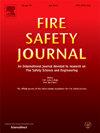Modelling aerodynamics and combustion of firebrands in long-range spotting
IF 3.4
3区 工程技术
Q2 ENGINEERING, CIVIL
引用次数: 0
Abstract
During a wildfire, parts of the vegetation such as twigs or bark can detach, ignite and become firebrands or embers. When they travel ahead from the main fire front, they can ignite secondary fires in a process known as spotting. We introduce pyBrands, an open-source python tool that uses coupled fire-atmosphere simulations to calculate firebrand trajectories. This module integrates aerodynamic and combustion models for firebrands. This study compares the existing drag and lift models, and combustion models for firebrands by simulating a realistic wildfire plume in a large numerical domain. Firebrands with different properties were injected into the plume and their landing densities were compared. Results indicate that travelled distances strongly depend on the aerodynamic and combustion model. This makes the choice of models difficult and impractical due to the required time step. pyBrands could be used to test and develop new models, improving firebrand behavior prediction in wildfires.

远距离点火过程中燃烧物的模拟、空气动力学和燃烧
在野火中,部分植被,如树枝或树皮会脱落,点燃并成为火种或余烬。当它们从主要火场向前移动时,它们可以在一个被称为点状的过程中点燃二次火灾。我们介绍pyBrands,这是一个开源的python工具,它使用耦合的火-大气模拟来计算火种轨迹。该模块集成了燃烧器的空气动力学和燃烧模型。通过在大数值范围内模拟真实的野火羽流,比较了现有的阻力、升力模型和燃烧模型。在羽流中注入不同性质的燃烧弹,并对其着陆密度进行了比较。结果表明,飞行距离在很大程度上取决于气动和燃烧模型。由于所需的时间步长,这使得模型的选择变得困难和不切实际。pyBrands可以用来测试和开发新的模型,改善野火中火种行为的预测。
本文章由计算机程序翻译,如有差异,请以英文原文为准。
求助全文
约1分钟内获得全文
求助全文
来源期刊

Fire Safety Journal
工程技术-材料科学:综合
CiteScore
5.70
自引率
9.70%
发文量
153
审稿时长
60 days
期刊介绍:
Fire Safety Journal is the leading publication dealing with all aspects of fire safety engineering. Its scope is purposefully wide, as it is deemed important to encourage papers from all sources within this multidisciplinary subject, thus providing a forum for its further development as a distinct engineering discipline. This is an essential step towards gaining a status equal to that enjoyed by the other engineering disciplines.
 求助内容:
求助内容: 应助结果提醒方式:
应助结果提醒方式:


